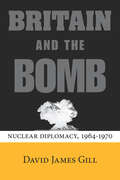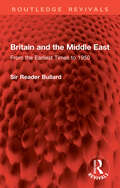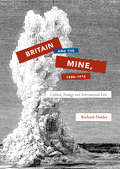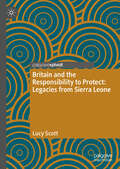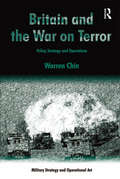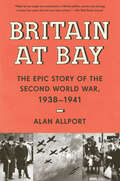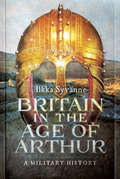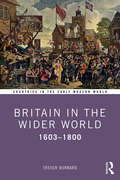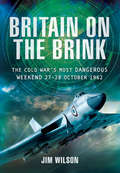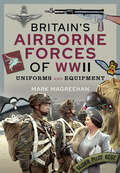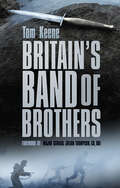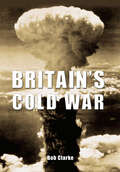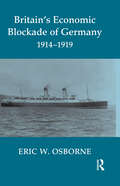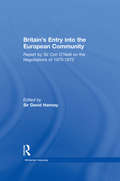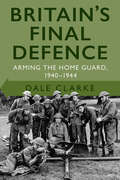- Table View
- List View
Britain and the Bomb: Nuclear Diplomacy, 1964-1970
by David James GillDrawing on primary sources from both sides of the Atlantic, Britain and the Bomb explores how economic, political, and strategic considerations have shaped British nuclear diplomacy. The book concentrates on Prime Minister Harold Wilson's first two terms of office, 1964-1970, which represent a critical period in international nuclear history. Wilson's commitment to the Non-Proliferation Treaty and his support for continued investment in the British nuclear weapons program, despite serious economic and political challenges, established precedents that still influence policymakers today. The continued independence of Britain's nuclear force, and the enduring absence of a German or European deterrent, certainly owes a debt to Wilson's handling of nuclear diplomacy more than four decades ago. Beyond highlighting the importance of this period, the book explains how and why British nuclear diplomacy evolved during Wilson's leadership. Cabinet discussions, financial crises, and international tensions encouraged a degree of flexibility in the pursuit of strategic independence and the creation of a non-proliferation treaty. Gill shows us that British nuclear diplomacy was a series of compromises, an intricate blend of political, economic, and strategic considerations.
Britain and the Dhofar War in Oman, 1963–1976: A Covert War in Arabia (Security, Conflict and Cooperation in the Contemporary World)
by Geraint HughesThis book explores Britain’s involvement in the Dhofar War of 1963-1976, focusing on the military aspects of this conflict in Southern Oman. It reveals how both the Conservative and Labour governments in office during this time provided military and security assistance to Oman’s rulers without parliamentary or press scrutiny. Based on archival material and witness accounts, as well as existing secondary source literature and memoirs, this study provides new insights into Britain’s clandestine embroilment in the Dhofar War, an often overlooked but historically significant intervention in the Middle East. This book will be a valuable resource for scholars and students interested in the complex and often controversial history of Britain’s involvement in Middle Eastern politics in the post-colonial period.
Britain and the First World War (Routledge Library Editions: The First World War)
by John TurnerThis book gives students an informed insight into the British experience in the First World War. The contributors, all established First World War historians, have drawn on their own research and secondary sources to give a succinct account of politics, diplomacy, strategy and social developments during a period of dramatic change. Each chapter gives a concise account of its subject and the chapters are well supported by maps and tables. This is an important textbook for school students and undergraduates which bridges the gap between specialized research on the First World War and the needs of the student reader.
Britain and the International Committee of the Red Cross, 1939-1945
by James CrosslandJames Crossland's work explores the tumultuous relationship that existed during the Second World War between a neutral, impartial humanitarian organization the International Committee of the Red Cross and the British government, one of the conflict's key belligerents. Unlike the Red Cross, whose mandate was to provide immediate succour to any and all war victims wherever they were found, Britain's wartime humanitarian policy was that victory would have to come before relief unfettered humanitarian action within Hitler's domain would have to wait for the arrival of Allied troops on European shores. Tracing the struggle of the International Committee of the Red Cross to work within the confines of this policy, this book tells the untold story of one of the more unusual battles of the Second World War: the battle fought within the corridors of power in Whitehall and Geneva and the camps of the Third Reich and the Far East between Swiss humanitarians and British war-makers. "
Britain and the Middle East: From the Earliest Times to 1950 (Routledge Revivals)
by Sir Reader BullardFirst published in 1951, Britain and the Middle East sets forth briefly the relations which the people and the government of Britain had with the Middle East from the earliest records of such relations until 1950. The term “Middle East” used in this book includes what used to be called the Near East as well as most of the Middle East proper. It covers Turkey and Iran (Persia), Cyprus, Syria and Lebanon, Palestine and Trans-Jordan (Israel and Jordan), Iraq, Egypt, the Sudan, and the whole of the Arabian Peninsula.
Britain and the Mine, 1900–1915: Culture, Strategy And International Law
by Richard DunleyThis book examines Britain’s complex relationship with the mine in the years 1900-1915. The development of mine warfare represented a unique mix of challenges and opportunities for Britain in the years before the First World War. The mine represented the antithesis of British maritime culture in material form, and attempts were made to limit its use under international law. At the same time, mine warfare offered the Royal Navy a solution to its most difficult strategic problem. Richard Dunley explores the contested position occupied by the mine in the attitudes of British policy makers, and in doing so sheds new light on the overlapping worlds of culture, strategy and international law.
Britain and the Responsibility to Protect: Legacies from Sierra Leone (Twenty-first Century Perspectives on War, Peace, and Human Conflict)
by Lucy ScottOver the last two decades the frequency of humanitarian interventions in Africa has increased. The British military intervention in the Sierra Leonean civil war in the early 2000s is often cited as an example of successful intervention and solidified Security Sector Reform (SSR) as a key component of state-building and development. Yet in-depth analysis of the long-term legacies of this ‘successful’ intervention are sparse and there remains a notable dearth in research exploring the British involvement from the perspectives of those directly affected. This book provides a novel outlook by exploring micro-level experiences, thus addressing this lacuna through examining the legacies within Sierra Leone and in British foreign policy from an experiential perspective. The Responsibility to Protect (R2P) is used as a framework to draw out implications for global intervention practice, as arguably R2P must also be accompanied by a responsibility to fully understand the legacy of this social phenomenon. By exploring the link between official narratives and the perspectives of those on the ground, a disconnect is exposed and important nuances are identified within the interpretation of the success of the British intervention. Through a critical analysis of these experiences significant questions are raised regarding the dynamics between intervening forces and the affected population; perceptions of legitimacy; accountability; and the implications for R2P more broadly.
Britain and the War on Terror: Policy, Strategy and Operations (Military Strategy and Operational Art)
by Warren ChinWhy did Britain come to play such a prominent role in the war on terror and why did the military instrument come to be the dominant theme in the British prosecution of what was an ideological and political struggle? This book is an analysis of Britain’s war against Al Qaeda and the phenomenon of international terrorism which marked a paradigm shift in the nature and conduct of war in the twenty-first century. At the heart of the book is an attempt to understand why Britain, which possessed a wealth of experience in the conduct of counterterrorism, counterinsurgency and small wars, developed a strategic and operational design to defeat the Islamist threat which proved to be deeply flawed. In addressing this question the book explores the complex intellectual, doctrinal and geopolitical challenge posed by Al Qaeda and international terrorism and how and why the British response took the form that it did. In conducting this analysis the book raises important questions about the assumptions and perceptions of those in government who led the UK into this conflict, the nature of the civil military relationship in Britain and how well it functioned, and finally the competence of its security forces in being able to deal with this threat both domestically and overseas.
Britain at Bay: Defence Against Bonaparte, 1803-14
by Richard GloverIn the years 1803-5 Napoleon Bonaparte built 4 new harbours on his channel coast and assembled enough landing craft to put an army of over 165,000 men ashore on English beaches. Was this threat to Britain really serious and should we dismiss it as pure Bluff? Why was it never revived after Bonaparte's continental wars against the Russians, Austrians and Prussians? What did the English do about defending themselves? This book, originally published in 1973 tackles these questions. It shows why Bonaparte's flotilla was no Bluff but something the British were right to take seriously and also how their preparations to defend the beaches within reach of its bases made a revival of the flotilla after 1807 pointless. Though recognising the importance of Trafalgar the book rejects the fallacy that this victory ended Britain's danger. The book covers the background of the war, Britain's defence organisation, the Royal Navy's tasks, Bonaparte's preparations and how the British made ready to meet him.
Britain at Bay: The Epic Story of the Second World War, 1938-1941
by Alan AllportA sweeping, groundbreaking epic that combines military with social history, to illuminate the ways in which Great Britain and its people were permanently transformed by the Second World War.Here is the many-faceted, world-historically significant story of Britain at war. In looking closely at the military and political dimensions of the conflict's first crucial years, Alan Allport tackles questions such as: Could the war have been avoided? Could it have been lost? Were the strategic decisions the rights ones? How well did the British organize and fight? How well did the British live up to their own values? What difference did the war make in the end to the fate of the nation?In answering these and other essential questions he focuses on the human contingencies of the war, weighing directly at the roles of individuals and the outcomes determined by luck or chance. Moreover, he looks intimately at the changes in wartime British society and culture. Britain at Bay draws on a large cast of characters--from the leading statesmen and military commanders who made the decisions, to the ordinary men, women, and children who carried them out and lived through their consequences--in a comprehensible and compelling single history of forty-six million people. For better or worse, much of Britain today is ultimately the product of the experiences of 1938-1941.
Britain at Bay: The Epic Story of the Second World War: 1938-1941
by Alan AllportWINNER OF THE HWA NON-FICTION CROWNA TIMES AND SPECTATOR BOOK OF THE YEAR'Britain's wartime story has been told many times, but never as cleverly as this.' Dominic SandbrookIn the bleak first half of the Second World War, Britain stood alone against the Axis forces. Isolated and outmanoeuvred, it seemed as though she might fall at any moment. Only an extraordinary effort of courage - by ordinary men and women - held the line. The Second World War is the defining experience of modern British history, a new Iliad for our own times. But, as Alan Allport reveals in this, the first part of a major new two-volume history, the real story was often very different from the myth that followed it. From the subtle moral calculus of appeasement to the febrile dusts of the Western Desert, Allport interrogates every aspect of the conflict - and exposes its echoes in our own age.Challenging orthodoxy and casting fresh light on famous events from Dunkirk to the Blitz, this is the real story of a clash between civilisations that remade the world in its Image.
Britain at War with the Asante Nation, 1823–1900: "The White Man's Grave"
by Stephen ManningThis authoritative military history chronicles the significant but overlooked colonial wars between the British and the Asante of West Africa.Throughout the nineteenth century, Britain fought three major wars, and two minor ones, with the Asante people of West Africa. Like the Zulus, the Asante were a warrior nation who offered a tough adversary for the British regulars. And yet these wars are rarely studied and little understood. In this insightful and vividly detailed volume, Stephen Manning sheds much-needed light on the history of this neglected colonial conflict. In the war of 1823–6, the British endured a defeat so absolute that the British governor’s head was severed and taken to the Asante king. Fifty years later, Sir Garnet Wolseley overcame many of the challenges British expeditionary forces faced in the jungle region known as ‘The White Man’s Grave’. Finally, the 1900 campaign culminated in the epic defeat of the Asante at the British fort in Kumasi. Stephen Manning’s account, which is based on Asante as well as British sources, offers a fascinating view from both sides of one of the most remarkable and protracted struggles of the colonial era.
Britain in Vietnam: Prelude to Disaster, 1945–46 (Military History and Policy)
by Peter NevilleThis book is a study of the circumstances leading to British intervention in Vietnam in 1945, and the course and consequences of this intervention. The first part of the work links French colonialism with the native communist insurgency, while examining British and Foreign Office attitudes towards French Indochina. The study then looks at the key Anglo-American wartime relationship concerning Indochina and its impact. The second half of the book focuses on the local problems faced by the British in Southern Indochina, and whether commanding general Douglas Gracey was guilty (as critics have suggested) of collusion with French colonialism. It also examines the wider problems linked to available military resources, and the controversial issues of the role of the OSS and the use of Japanese troops to preserve law and order. Finally, the book makes a groundbreaking link between British intervention and the outbreak of the French-Vietminh war in 1946. Britain in Vietnam will be of interest to students of British foreign policy, military history and South-East Asian history in general.
Britain in the Age of Arthur: A Military History
by Ilkka Syvänne“[The] well known historian . . . attempts to find the elusive King Arthur through a study of the military of the period following the Fall of Rome.” —FiretrenchKing Arthur is one of the most controversial topics of early British history. Are the legends based on a real historical figure or pure mythological invention? Ilkka Syvänne’s study breaks new ground, adopting a novel approach to the sources by starting with the assumption that Arthur existed and that Geoffrey of Monmouth’s account has preserved details of his career that are based on real events. He then interprets these by using “common sense” and the perspective of a specialist in late Roman military history to form a probable picture of what really happened during the period (roughly AD 400-550). This approach allows the author to test the entire literary evidence for the existence of Arthur to see if the supposed events of his career match what is known of the events of the period, the conclusion being that in general they do. Arthur’s military career is set in the context of the wider military history of Britain and Europe in this period and along the way describes the nature of armies and warfare of the period.“Anything about Arthur is worth a read in my opinion, and this is a great addition to the growing body of work on the mythical King.” —Books Monthly
Britain in the Wider World: 1603–1800 (Countries in the Early Modern World)
by Trevor BurnardBritain in the Wider World traces the remarkable transformation of Britain between 1603 and 1800 as it developed into a world power. At the accession of James VI and I to the throne of England in 1603, the kingdoms of England/Wales, Scotland and Ireland were united only by having a monarch in common. They had little presence in the world and were fraught with violence. Two centuries later, the consolidated state of the United Kingdom, established in 1801, was an economic powerhouse and increasingly geopolitically important, with an empire that stretched from the Americas, to Asia and to the Pacific. The book offers a fresh approach to assessing Britain’s evolution, situating Britain within both imperial and Atlantic history, and examining how Britain came together politically and socially throughout the eighteenth century. In particular, it offers a detailed exploration of Britain as a fiscal-military state, able to fight major wars without bankrupting itself. Through studying patterns of political authority and gender relationships, it also stresses the constancy of fundamental features of British society, economy, and politics despite considerable internal changes. Detailed, accessibly written, and enhanced by illustrations, Britain in the Wider World is ideal for students of early modern Britain.
Britain on the Brink: The Cold War's Most Dangerous Weekend, 27–28 October 1962
by Jim WilsonThis Cold War history examines the Cuban Missile Crisis from a British perspective, following events as they developed in London, Washington, and Moscow. During the Cold War, the possibility of nuclear destruction was never too far away. But for several days in October of 1962, that possibility came closer than most civilians could ever imagine. The Cuban Missile Crisis put the UK squarely on the frontlines, with the Strategic Air Command&’s UK bases on high alert. Nuclear weapons were loaded, some nuclear-armed aircraft went on round-the-clock airborne patrol, and others were held at cockpit readiness.Britain on the Brink examines how the UK was threatened by the Soviet Union&’s deployment of nuclear missiles ninety miles off the US coast. It looks at secret planning in the UK for World War III, and the activities of the JIGSAW Group (Joint Inter-Services Group for the Study of All-Out War). It also examines how close the UK went to activating Visitation, the code name for the movement of parts of the British State into a secret bunker referred to in Whitehall as The Quarry.
Britain's Airborne Forces of WWII: Uniforms and Equipment
by Mark MagreehanThe Second World War saw huge advancements in military tactics and technology occurring at an unprecedented pace. One such development was the employment of forces able to deploy at short notice by parachute across the globe, utilizing the opportunities created by the advancements in aeronautical technology. These forces were created to deliver an in-depth shock effect, and few have attracted more attention than Britain’s famed Parachute Regiment. This formation was born from the humble beginnings of a fledgling unit drawn together from the British Army and Royal Air Force after Winston Churchill called for a new capability to be created following German airborne successes in the opening stages of the Second World War. Despite being initially poorly equipped, operating outdated aircraft and wearing clothing copied from captured German examples, the Parachute Regiment rapidly grew into what would become two complete airborne divisions – formations which played a key role in the destruction of the Axis forces. The equipment needed by these men rapidly changed as the war evolved and this is clearly illustrated in the author’s fine and unique collection of rare airborne items from that period, several of them being the sole surviving items known to exist. The chronological historical information on Britain’s paratroopers’ role and development during the Second World War in this highly illustrated book is not only supported by a comprehensive and rare collection of items displaying the development and expansion of their equipment for each operation, but also by hundreds of original pictures which embrace the entire period. Additionally, the book also briefly covers the Polish Parachute Brigade and the Canadian parachute formations embedded into the British order of battle. This book provides a comprehensive pictorial display of Britain airborne forces which will prove to be a ‘must have’ tool for military history enthusiasts, airborne collectors, re-enactors and modelers, as well as current serving soldiers linked by service to this truly special military formation.
Britain's Anti-submarine Capability 1919-1939 (Cass Series: Naval Policy and History #Vol. 17)
by George FranklinBritain's Anti-Submarine Capability, 1919-1939 is the first unified study of the development of Britain's anti-submarine capability between the armistice in 1919 and the onset of the second world German submarine attack on Britain's maritime trade in 1939. Well researched and yet accessibly written, this book challenges the widespread belief that the Royal Navy failed to anticipate the threat of the U-boat in the Second World War.
Britain's Band of Brothers
by Tom Keene Julian ThompsonThey were Britain’s Second World War ‘Band of Brothers’, a secret army of fifty handpicked, cross-Channel raiders who carried the fight to the enemy shore long before D-Day. Created after the fall of Dunkirk, they commandeered a Brixham fishing boat and planned clandestine attacks on German warships in the Channel. But not all their enemies wore German uniform. Thwarted by rivals working for Britain’s Secret Intelligence Service (SIS), the unit sailed to West Africa where, as part of Special Operations Executive (SOE), they carried out an audacious top-secret raid on neutral shipping. Returning to Britain in triumph and feted now by Churchill himself, they expanded into the Small Scale Raiding Force. In almost twenty daring missions for Combined Operations, whilst operating from a secret manor house in Dorset, they raided German outposts, kidnapped sentries, ambushed patrols and shot prisoners, all the while sowing fear and havoc along the rim of Hitler’s Fortress Europe. Britain’s Band of Brothers is their story of courage and comradeship, of patriotism, tragedy and dawn-cold courage, told here in full for the first time.
Britain's Brigade of Gurkhas (Famous Regiments)
by E. D. SmithFour regiments of Nepalese mountaineers remained with the British Army after Indian independence. They have seen a great deal of tough campaigning, particularly in Southeast Asia. This new edition updated to include Gurkha participation in the Falklands.
Britain's Cold War
by Bob Clarke'From Stettin in the Baltic to Trieste in the Adriatic an iron curtain has descended across the Continent.' So said Winston Churchill in 1946. About to begin was Britain's most expensive and turbulent periods of military history. Four Minute Warning is the story of Britain's Cold War, and it deals with all aspects of this chilling time when Britain could have been obliterated so easily by the unleashing of Russian Nuclear Weapons. The Cold War was like no other conflict yet experienced. It was more than a struggle between two superpowers, it was a war of ideologies, the Capitalistic West and the Communist East. The Cold War leached its way into every facet of British life to the extent it was not really considered a war at all. But a war it was. The period was punctuated by an arms race which pushed the world to the edge of destruction, as both East and West amassed arsenals of nuclear weapons far beyond what would be needed to destroy, quite literally, everything. So what part did Britain play in all this? Read on and find out!
Britain's Desert War in Egypt & Libya, 1940–1942: 'The End of the Beginning'
by David BraddockThis concise WWII history covers the Western Desert Campaign from Operation Compass to the Battle of El Alamein. The fighting in Libya and Egypt during the Second World War has deservedly attracted the attention of many historians. While best remembered for the duel between Montgomery&’s Eighth Army and Rommel&’s Afrika Korps and the iconic Battle of El Alamein, historian David Braddock reveals that there was much more to the story. This volume sheds light on the exploits of British Army commander Sir Claude Auchinleck, who took over Middle East Command in 1941. Braddock also details the leadership of Field Marshal Alexander and many other gifted commanders who led and fought in the Battles of Gazala, Bir Hakeim, Alam Halfa and Tobruk. Both the Allied and Axis powers employed weapons that have passed into immortality, such as Germany&’s Tiger and Panther tanks and lethal 88mm antitank gun. The Messerschmitt BF109 fighter locked horns with desert-modified Spitfires and Hurricanes. The author highlights the vital roles of the Royal Navy, disrupting enemy supplies, and the Royal Air Force, which eventually gained command of the air.
Britain's Economic Blockade of Germany, 1914-1919 (Cass Series: Naval Policy And History Ser. #Vol. 24)
by Eric W. OsborneGreat Britain's economic blockade of Germany in World War I was one of the key elements to the victory of the Entente. Though Britain had been the leading exponent of blockades for two centuries, the World War I blockade was not effective at the outbreak of hostilities. Pre-war changes had led to the Admiralty supplanting the Royal Navy's leadershi
Britain's Entry into the European Community: Report on the Negotiations of 1970 - 1972 by Sir Con O'Neill (Whitehall Histories)
by Sir David HannayIn January 1972 Britain signed the Treaty of Acccession to the European Community. Sir Con O'Neill, a key figure in the negotiations, gives an analysis of negotiations which had an impact on Britain's relations with Europe, and insights into the processes of multilateral diplomacy.
Britain's Final Defence: Arming the Home Guard 1940-1944
by Dale ClarkeKnown affectionately as ‘Dad’s Army’, the Home Guard was Britain’s very serious attempt to protect our shores from invasion by Nazi Germany in the Second World War. In the ‘Spitfire summer’ of 1940, all that the 1 million unpaid, untrained part-timers of the Local Defence Volunteers (as the organisation was originally called) wanted was a service rifle for each man, but even that was too much for a country threatened by defeat to provide. Britain’s Final Defence is the first book to explore the efforts made to arm the home defence force between 1940 and 1944 and describe the full range of weaponry available for Britain’s last stand against invading Axis forces.
